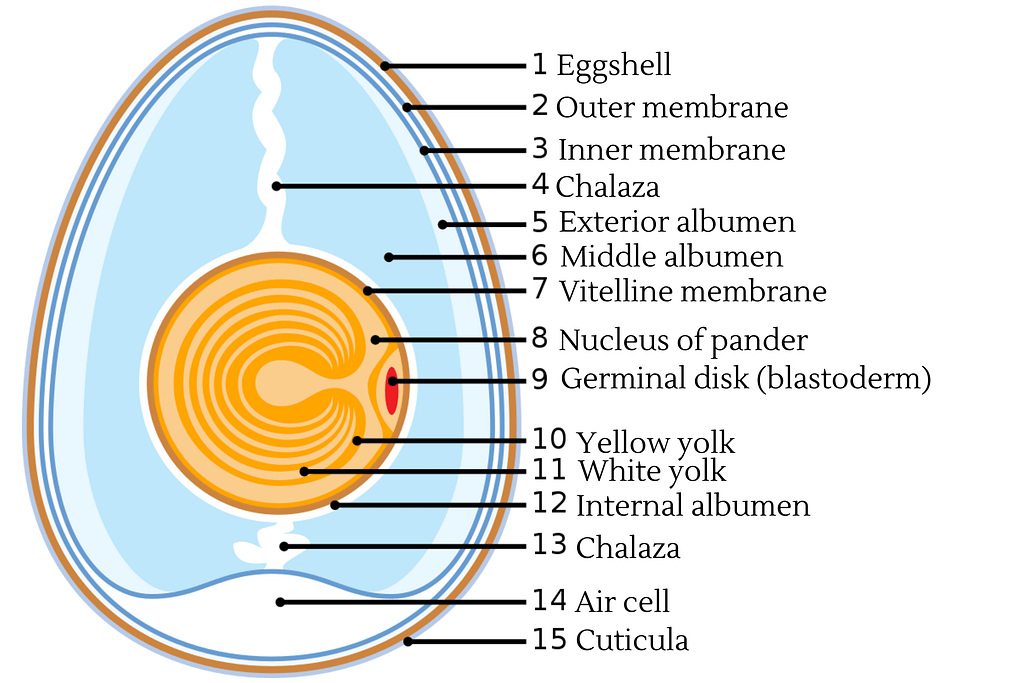In the unassuming form of a chicken egg lies a marvel of nature’s design. This seemingly simple object, found in kitchens worldwide, is anything but basic.
The egg, a fundamental part of our diets, holds within it a universe of intricate biological intricacies. From the protective shell to the nutrient-rich yolk, each element serves a vital purpose in nurturing life and sustaining both avian embryos and our culinary preferences.
Understanding the scientific makeup of a chicken egg unveils a captivating story of structural ingenuity and biological functionality, showcasing nature’s mastery in crafting an unassuming yet extraordinary creation.

Eggshell (1)
The eggshell, is a remarkable feat of natural engineering. Comprising primarily calcium carbonate crystals and a protein matrix, the shell provides a sturdy yet porous protective covering. This intricate structure not only shields the egg’s contents from external harm but also allows for vital gas exchange. The shell’s porous nature enables oxygen to enter the egg while permitting carbon dioxide to exit, crucial for the growing embryo’s respiratory needs.
Beyond its protective function, the shell’s strength and integrity are paramount, ensuring the safety of the developing life within. While seemingly delicate, the eggshell’s composition and design highlight nature’s precision, offering a blend of resilience and vulnerability that contributes to the egg’s significance in both biological development and culinary endeavors.
Outer Membrane (2)
The outer membrane of a chicken egg, nestled just beneath the protective shell, plays a crucial role in safeguarding the egg’s contents. Comprised of proteins and fibers, this membrane acts as an additional line of defense against potential bacterial intrusion. Its presence helps maintain the egg’s structural integrity while retaining essential moisture vital for the embryo’s development.
Functioning as a barrier, the outer membrane acts in conjunction with the shell, creating a protective shield against harmful microorganisms, ensuring a conducive environment for the egg’s growth. Despite its often overlooked role, the outer membrane represents a vital component in preserving the integrity of the egg, contributing to the overall protection and viability of its contents.
Inner Membrane (3)
The inner membrane within a chicken egg, nestled beneath the outer membrane and encasing the egg white (albumen), serves as a crucial guardian of the egg’s integrity. Composed of proteins and fibers, this membrane closely adheres to the albumen, providing structural support and stability. Functioning as a protective barrier, the inner membrane acts as a barrier against bacterial invasion, shielding the delicate contents of the egg from potential harm. It aids in retaining the egg’s moisture, crucial for the proper development of the growing embryo. While often overshadowed by the outer shell and the egg’s other components, the inner membrane’s role in preserving the egg’s internal environment showcases nature’s meticulous design, ensuring a conducive setting for the embryo’s growth and protection against external threats.
Chalaza (4 & 13)
The chalaza, a lesser-known yet essential part of a chicken egg, comprises twisted, rope-like structures made of protein. Extending from the egg yolk’s surface and intertwining with the egg white (albumen), these chalazae serve a vital function in anchoring the yolk in place. Acting as natural stabilizers, they prevent excessive movement of the yolk within the egg, safeguarding the developing embryo from potential physical damage. Though often noticed in the egg white, these unassuming structures play a pivotal role in maintaining the yolk’s position, ensuring its central location for proper nourishment and protection throughout the egg’s development. While inconspicuous, the chalazae’s role in maintaining structural stability within the egg highlights the intricacies of nature’s design, contributing to the safe incubation and development of avian life.
Exterior Albumen (5)
The exterior albumen, a key component of a chicken egg, encompasses the portion of egg white closest to the shell. Comprised mainly of water and proteins like ovalbumin, this region acts as a protective layer, offering a first line of defense for the developing embryo. While thinner in consistency compared to the inner egg white, the exterior albumen contributes to the egg’s overall structural integrity and defense against potential microbial threats. It assists in cushioning and shielding the yolk, providing an added layer of protection against physical impacts that could harm the delicate embryo. Despite its often overlooked presence, the exterior albumen forms an integral part of the egg’s defense mechanisms, ensuring a conducive environment for the embryo’s development within the egg.
Middle Albumen (6)
The middle albumen, nestled between the exterior albumen and the innermost egg white, constitutes a substantial portion of the egg’s content. Rich in proteins like ovotransferrin and ovomucin, this viscous layer provides essential nutrients and structural support crucial for the developing embryo. Its consistency, thicker than the exterior albumen, contributes to the overall stability of the egg. The middle albumen acts as a buffer, protecting the yolk and embryo from sudden shocks or impacts. Additionally, it aids in maintaining proper moisture levels within the egg, creating a conducive environment for embryonic growth. Despite its understated appearance, the middle albumen’s role in providing a nurturing and protective environment for the developing life within the egg is pivotal, showcasing the intricate design and functionality of this often-overlooked component.
Vitelline Membrane (7)
The vitelline membrane, a delicate yet crucial layer surrounding the egg yolk, forms a protective barrier, safeguarding the yolk’s integrity. Comprised of proteins and fibers, this semi-permeable membrane encases the yolk, separating it from the egg white. Its primary role involves maintaining the structural integrity of the yolk and preventing potential damage or disruption. Acting as a shield, the vitelline membrane ensures the yolk remains intact, preserving the essential nutrients vital for the developing embryo’s nourishment. While often unseen, the vitelline membrane plays a pivotal role in maintaining the yolk’s structural integrity and safeguarding the embryo’s vital source of nutrients, highlighting the intricate mechanisms that contribute to the egg’s nurturing environment.
Nucleus of Pander (8)
The nucleus of Pander, an embryonic remnant found in avian eggs, specifically within the egg yolk, represents an essential structure in embryonic development. It is a remnant of the ovum’s nucleus, which contributes to the formation of the embryo during fertilization. While initially present in the egg yolk, it gradually diminishes as the egg matures and is usually not observable in developed eggs. Despite its diminutive size and eventual disappearance, the nucleus of Pander signifies an early stage in avian embryogenesis, symbolizing the initial cellular components involved in the formation of life within the egg. Its presence, though transient, underscores the continuity of life’s developmental processes within avian species.
Germinal Disk/Blastoderm (9)
The germinal disk, also known as the blastoderm, is a crucial structure within the chicken egg yolk that holds the potential for embryo development if the egg is fertilized. This tiny, disc-shaped region marks the point where the sperm’s penetration initiates cell division and embryonic growth. Composed of cells containing the genetic material necessary for the formation of the embryo, the germinal disk is rich in nutrients and acts as the epicenter for early embryonic development. If fertilization occurs, the cells within the germinal disk rapidly divide and differentiate to form the intricate structures and tissues of the developing embryo. While barely noticeable to the naked eye, the germinal disk represents the epicenter of life’s commencement within the egg, harboring the genetic blueprint for potential embryonic growth and development.
Yellow and White Yolk (10 & 11)
In a chicken egg, the yolk consists of two distinguishable regions: the yellow yolk and the egg white or albumen. The yellow yolk, often referred to as the nucleus, is the core of the egg’s nutritional reservoir. Rich in proteins, fats, vitamins, and minerals, the yellow yolk serves as the primary source of nutrients for the developing embryo if the egg is fertilized. Its distinctive golden hue is attributed to carotenoid pigments, which also contribute to its nutritional value.
In contrast, the egg white or albumen comprises primarily water and proteins. Divided into different layers—exterior, middle, and inner— the egg white encircles the yolk, providing structural support, cushioning, and protective layers for the embryo. The egg white contains various proteins, including ovalbumin and ovotransferrin, essential for nourishing and protecting the developing embryo. While less dense in nutrients compared to the yolk, the egg white plays a critical role in shielding the yolk and providing a conducive environment for embryonic growth.
Both the yellow yolk and the egg white work synergistically to nurture the embryo within the egg. Their complementary compositions and functionalities contribute to the balanced environment necessary for the development of avian life.
Internal Albumen (12)
The internal albumen, also known as the middle albumen, constitutes a significant part of the egg white in a chicken egg. Rich in proteins like ovotransferrin and ovomucin, this layer plays a pivotal role in protecting and nourishing the developing embryo. It forms a cushioning and stabilizing layer around the yolk, providing structural support and insulation against external impacts or shocks.
The internal albumen’s thicker consistency compared to the exterior albumen adds to the egg’s overall stability. This layer aids in maintaining proper moisture levels within the egg, creating an optimal environment for embryonic growth and development. While less noticeable than the exterior albumen, the internal albumen’s presence within the egg contributes significantly to the nurturing environment required for the embryo’s well-being.
Air Cell (14)
The air cell, a crucial feature in a chicken egg, develops as the egg ages and undergoes natural changes. Found at the wider end of the egg, this airspace forms between the inner and outer membranes as the egg loses moisture and carbon dioxide through its porous shell.
As the egg ages, the air cell grows larger due to moisture loss, and its size becomes an indicator of freshness. It plays a crucial role in the egg’s respiration, providing the developing embryo with the necessary oxygen once it begins to grow. Additionally, the air cell serves as a determinant of the egg’s freshness, as the size of the air cell increases over time.
While seemingly simple, the air cell’s presence within the egg is a vital aspect of the egg’s aging process and serves as a marker of its viability for consumption or incubation. Its formation reflects the natural progression of the egg’s internal changes and plays a pivotal role in sustaining the embryo’s respiratory needs during development.
Cuticula (15)
The cuticle, or bloom, of a chicken egg is a natural protective layer that covers the shell’s surface. Composed of proteins and other organic substances secreted by the hen’s reproductive system, this thin film acts as a barrier against bacterial contamination.
The primary role of the cuticle is to seal the pores on the eggshell, reducing moisture loss and preventing bacteria from entering the egg. It serves as a natural defense mechanism, preserving the egg’s freshness and integrity. However, washing or cleaning eggs removes this protective layer, making the egg more susceptible to bacterial infiltration and faster spoilage.
While nearly invisible to the naked eye, the cuticle’s presence on the eggshell significantly contributes to its protection and longevity. Its natural properties play a crucial role in maintaining the egg’s quality and safeguarding its contents against external contaminants, showcasing nature’s intricate mechanisms for preserving the integrity of chicken eggs.

